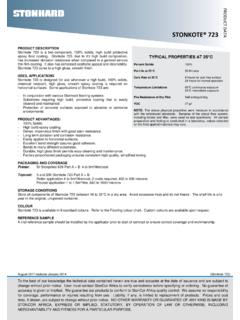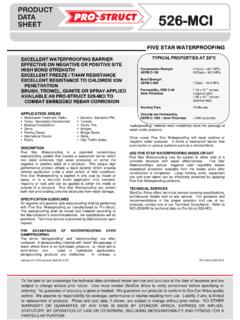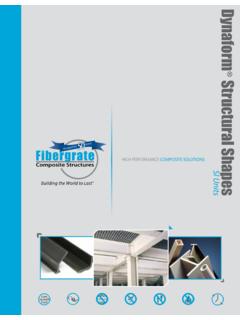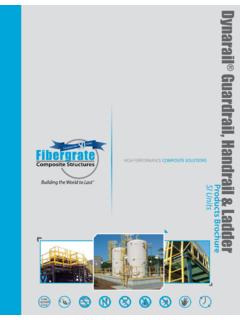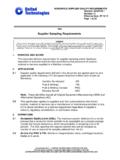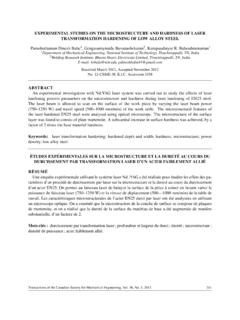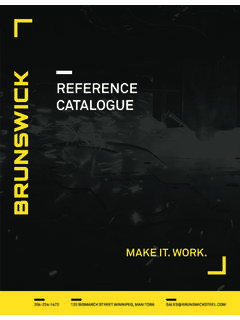Transcription of 200 ZA
1 Carbomastic 200 ZA. product data SELECTION data SPECIFICATION data . GENERIC TYPE: Epoxy-polyamide coal tar. Part A and Part B THEORETICAL SOLIDS CONTENT OF MIXED. mixed prior to application. MATERIAL: GENERAL PROPERTIES: A heavy duty, high build epoxy-coal By Volume tar coating for protection of steel and concrete. Easily applied at Carbomastic 200 ZA 74% 2%. up to 200 microns in one coat. Material is self-priming. Availability of two colours enables contrast during application. RECOMMENDED DRY FILM THICKNESS PER COAT: 200 microns RECOMMENDED USES: For protection of steel and concrete surfaces from corrosive environments. Good for dams, gates, THEORETICAL COVERAGE :*. penstocks (interior and exterior), offshore drilling structures and m /l at 200 microns marine environments, barge and tank hull interiors carrying sour crude and salt water ballast.
2 Good for concrete and steel *NOTE: Material losses during mixing and application will surfaces in sewage disposal plants, pulp and paper mills, vary and must be taken into consideration when estimating chemical plants, etc. job requirements. NOT RECOMMENDED FOR: Immersion in aromatic or ketone SHELF LIFE: 24 months minimum when stored at 25 C. solvents, or strong oxidizing acids. COLOURS: Black and Red. CHEMICAL RESISTANCE GUIDE: GLOSS: High initial, becomes flat. Splash and Exposure Immersion Spillage Fumes Acids Very Good Excellent Excellent ORDERING INFORMATION. Alkalies Very Good Excellent Excellent Solvents Prices may be obtained from StonCor Africa sales (Aliphatic) Fair Very Good Very Good representative or main office. Salt Excellent Excellent Excellent Water Excellent Excellent Excellent APPROXIMATE SHIPPING WEIGHT: 5L.
3 TEMPERATURE RESISTANCE (non-immersion) : Carbomastic 200 ZA 7,8 kg Carbomastic Thinner 4,9 kg Continuous: 70 C. Carboline Surface Preparation #1 4,8 kg Non-continuous: 93 C. FLASH POINT (Pensky-Martens Closed Cup): For immersion, temperature depends on exposure, but the Carbomastic 200 ZA Part A 28 C. maximum is 49 C. Carbomastic 200 ZA Part B >81 C. FLEXIBILITY: Fair Carboline Thinner # 10 24 C. Carboline Surface Preparation #1 23 C. WEATHERING: Good (chalks). ABRASION RESISTANCE: Very Good SUBSTRATES: Apply to properly prepared concrete, steel or others as recommended. TOPCOAT REQUIRED: None required. COMPATIBILITY WITH OTHER COATINGS: Specific recommendations should be obtained before applying over old coatings. Coating is self-priming. January 2013 SA replaces March 2012 SA. To the best of our knowledge the technical data contained herein are true and accurate at the date of issuance and are subject to change without prior notice.
4 User must contact StonCor Africa to verify correctness before specifying or ordering. No guarantee of accuracy is given or implied. We guarantee our products to conform to StonCor Africa quality control. We assume no responsibility for coverage, performance or injuries resulting from use. Liability, if any, is limited to replacement of products. Prices and cost data , if shown , are subject to change without prior notice. NO OTHER. WARRANTY OR GUARANTEE OF ANY KIND IS MADE BY STONCOR AFRICA, EXPRESS OR IMPLIED, STATUTORY, BY OPERATION OF LAW OR. OTHERWISE, INCLUDING MERCHANTABILITY AND FITNESS FOR A PARTICULAR PURPOSE. APPLICATION INSTRUCTIONS. These instructions are not intended to show product recommendations for specific service. They are issued as an aid in determining correct surface preparation, mixing instructions and application procedure.
5 It is assumed that the proper product recommendations have been made. These instructions should be followed closely to obtain the maximum service from the materials. SURFACE PREPARATION: Remove any oil or grease from CONVENTIONAL: Use a 12mm minimum ID material hose. surface to be coated prior to abrasive blast or power tool cleaning. Hold gun approximately 300-350mm from the surface and at a right angle to the surface. STEEL: For immersion service, abrasive blast to a White Metal finish in accordance with ISO 8501 Sa3 to obtain a 50-75 micron Mfr. & Gun Fluid Tip Air Cap blast profile. For non-immersion service, abrasive blast to a Binks #18 or #62 67 67 PB. Commercial finish in accordance with ISO 8501 Sa2 to obtain a DeVilbiss P-MBC or JGA D (Approx..086 ID) 64. 50-75 micron blast profile. AIRLESS: Use 12mm minimum ID material hose.
6 Hold gun CONCRETE: Do not coat concrete treated with hardening solutions approximately 450-500mm from the surface and at a right unless test patch indicates satisfactory adhesion. Do not apply angle to the surface. coating unless concrete has cured at least 28 days at 25 C and 50%. or equivalent time. Apply to properly prepared concrete that Mfr. & Gun Pump*. has been acid etched or sweep sandblasted. Either below Huskie (DeVilbiss). Graco 207-300 Bulldog 30:1. MIXING: Power mix separately, then combine and mix in the Binks Model 520 Jupiter B8-36 37:1. following proportions. 5L Kit *Teflon packings are recommended and are available from Carbomastic 200 ZA Part A 4L manufacturer. Revers-A-Clean tip is recommended. Carbomastic 200 ZA Part B 1L Use a .019 - .025" tip with 2400 psi. (166 Bar). After mixing, allow 30-60 minutes induction during cold weather, BRUSH: Use a clean, short bristled brush.
7 Work coating into before thinning. all crevices and avoid rebrushing. Thin up to 15% by volume with Carboline Thinner # 10. DRYING TIME: Excessive film thickness or conditions of poor ventilation require longer dry times. NOTE: Use of thinners other than those supplied or approved by StonCor Africa may adversely affect product performance and void Surface Temp Minimum Maximum Cure product warranty, whether express or implied. & 50% RH Dry to Recoat Recoat For Touch Time Time Immersion 16 C 8hrs 12hrs 24 hrs 14 Days POT LIFE: Four hours at 25 C and less at higher temperatures. 24 C 4hrs 6hrs 24 hrs 7 Days Pot life ends when coating loses body and begins to sag. 32 C 2hrs 3hrs 24 hrs 5 Days APPLICATION TEMPERATURES: Condensation may result in a surface blush, which will affect Material Surfaces intercoat adhesion.
8 Wash surfaces thoroughly with clean, Normal 18-29 C 18-29 C potable water and allow to dry before topcoating. Minimum 13 C 10 C. Maximum 32 C 45 C In direct sunlight, topcoat within 36 hours, sandpaper then wipe surface with CARBOLINE Surface Preparation #1 to Ambient Humidity ensure good adhesion of next coat. Normal 16-32 C 35-70%. Minimum 10 C 0% Force curing is suggested for all tank linings. Maximum 40 C 90%. *If final cure is attained and recoat is necessary, special Do not apply when the surface temperature is less than 3 C above surface preparation may be required. the dew point. VENTILATION AND SAFETY: When used as a tank lining or Special thinning and application techniques may be required above in enclosed areas, thorough air circulation must be provided or below normal conditions. during and after application until the coating is cured.
9 The ventilation system should be capable of preventing the solvent SPRAY: Use sufficient air volume for correct operation of vapour concentration from reaching the lower explosion limit equipment. Use a 50% overlap with each pass of the gun. On for the solvents used. In addition to proper ventilation, fresh air irregular surfaces, coat the edges first, making an extra pass later. respirators or fresh air hoods must be used by all application personnel. Where flammable solvents exist, explosion proof NOTE: The following equipment has been found suitable, however, lighting equipment must be used. Hypersensitive persons equivalent equipment may be substituted. should wear protective clothing, gloves and/or protective cream on face, hands and all exposed areas. CLEAN UP: Use Carboline Thinner #2. STORAGE CONDITIONS (store indoors): Temperature: 7-43 C.
10 Humidity: 0-100%. CAUTION: MAY CONTAIN FLAMMABLE SOLVENTS. KEEP AWAY FROM SPARKS AND OPEN FLAMES. IN CONFINED AREAS WORKMEN MUST WEAR. FRESH AIRLINE RESPIRATORS. HYPERSENSITIVE PERSONS SHOULD WEAR GLOVES OR USE PROTECTIVE CREAM. ALL ELECTRONIC. EQUIPMENT AND INSTALLATIONS SHOULD BE MADE AND GROUNDED IN ACCORDANCE WITH THE NATIONAL ELECTRICAL CODE. IN AREAS. WHERE EXPLOSION HAZARDS EXIST, WORKMEN SHOULD BE REQUIRED TO USE NONFERROUS TOOLS AND TO WEAR CONDUCTIVE. AND NONSPARKING SHOES. Africa StonCor Africa (Pty) Ltd Co. Reg. No.: 1996/01848/07. Tel No : +27 11 254 5500. Website: E-mail.
